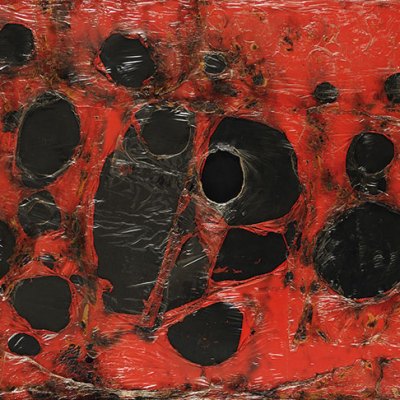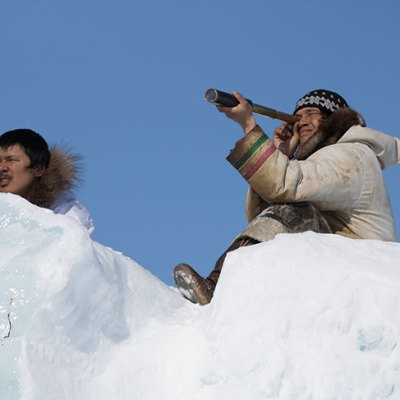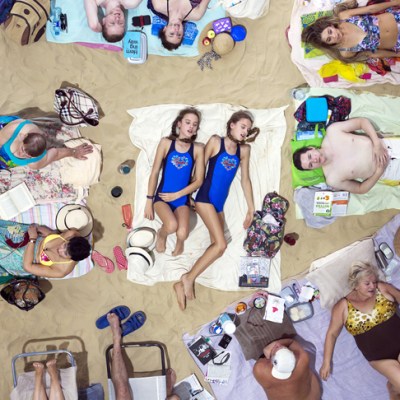Tuesday morning in Venice, on the first day of the Biennale preview, is cold but bright. My first stop, the Ateneo Veneto, isn’t itself part of the 56th International Art Exhibition. A lavishly decorated room holds an alien intruder: a white, minimalist porcelain box. This is the Library of Exile, a pavilion filled with 2,000 books by exiled writers – Ovid, Victor Hugo, Paul Celan, Salim Barakat – open to the sky and for now given shelter under the room’s richly painted, sloping ceiling. The pavilion was created by Edmund de Waal as part of his exhibition ‘Psalm’ (until 29 September). You can make out phrases on the structure’s external wall, scribbled on to a layer of porcelain: lists of the world’s lost libraries, from Nineveh to Mosul; the sentence ‘It’s always personal – I’m making this for my great-grandfather Viktor who saw his library stolen in Vienna’. It’s an assertion of the centrality, to De Waal’s creative imagination, of the white page of the book, of language, as much as of porcelain; he describes it as ‘the most significant sculpture of my life’.
We set off in a boat to find the other half of De Waal’s ‘Psalm’. In the plain courtyard of the Ghetto Nuovo, the artist explains that since its foundation in 1516 this space where Jews were once isolated has been ‘a place of translation’, with many languages spoken within its confines. He guides us into the Jewish Museum where he is the first contemporary artist to have been invited to exhibit work in the building. Positioned in the corridor outside the Scuola Canton, one of the Ghetto’s five synagogues, is a series of 11 austere vitrines: Tehillim, small white boxes each containing a block of near-translucent marble and a delicate piece of gilded porcelain, each representing one of the pieces of ‘poetry of exile’ that make up the Book of Psalms.
Tehillim (2018), Edmund de Waal. Installation view of ‘Psalm’, Canton corridor, Jewish Museum, Venice. Photo: Fulvio Orsenigo. Courtesy the artist; © Edmund de Waal

The themes of exile and migration recur throughout Venice this year, from collateral and external events to the national pavilions and main exhibition curated by Ralph Rugoff (until 24 November). For the latter, a rusted boat that sank in 96 kilometres off the Libyan coast in 2015, drowning hundreds of people who were fleeing the country, has been towed into the Arsenale. The controversial contribution of Swiss-Icelandic artist Christoph Büchel to this Biennale encapsulates the problematic nature of the art world, where tragic and difficult subjects collide with the carnival of wealth and spectacle that parades here.
Late on the first night I head to the grand but dilapidated Church of San Lorenzo which stands at the top of a short flight of stairs in the district of Castello. The streets around are dark and quiet but immediately in front of the now-deconsecrated church is a tremendous hubbub. The site opened at the end of March as the new headquarters of Francesca Thyssen-Bornemisza’s cross-displinary research centre Ocean Space, with a project titled ‘Moving Off the Land II’ by Joan Jonas (until 29 September). Tonight Jonas herself is going to perform. But first we have to get in, and then we have to wait a full 45 minutes in the cold church, until just before midnight, as if purging ourselves of impatience before a revelation. The hour-long performance, in front of and in direct interaction with a film projected on to a screen behind her, is mesmerisingly beautiful. We watch the artist explore her kinship with the extraordinary fish and sea creatures depicted in the film.
I don’t make it down to the Giardini until the following day, which brings insistent cold rain. The British Pavilion is closed for the opening speeches, but my eye is caught by the film running in the Canadian Pavilion nearby. An intractable conversation between a bearded white man wrapped in furs referred to as ‘the Boss’ and an Inuit Elder, in an entirely white landscape, recreates a historic encounter on Baffin Island in 1961 in which one Inuit family was ordered off its land. One Day in the Life of Noah Piugattuk, made by Isuma, an Inuit collective, is utterly compelling. Breath turns to ice, as ‘the Boss’ reiterates that ‘No’ is not a possible answer and the Chief Elder repeatedly resists his blandishments, the camera close-up on this sham negotiation. Another screen carries the webcast series Silakut Live from the Floe Edge, which explores current plans for mining expansion in Inuit territory.
In the nearby Korean Pavilion, films by three women explore, variously, the aesthetics and politics of queer performance; experience of abandonment and exile among women in East Asia, and the life story of a female Korean dancer. In the film I stay with longest, Hwayeon Nam’s evocative Dancer from the Peninsula, Nam imagines herself, down to her sock-covered feet, into the life of Seunghee Choi. A dancer born in 1911, Choi learned to dance during the Japanese colonial period, incorporating elements of Japanese Noh and Chinese dance into her choreography, before finding herself in conflict with Korean nationalism in the Cold War.
Passage (production still; 2019), Nujoom Alghanem. Photo: Augustine Paredes of Seeing Things. Courtesy National Pavilion UAE – La Biennale di Venezia

After a quick dash to the Arsenale, through the multi-voiced gathering in Ralph Rugoff’s main exhibition, I climb up to the Turkish Pavilion. Here Inci Eviner, winner of the Sharjah Biennial Prize in 2017, and veteran of many biennials worldwide, has created an entire architectural environment. Her work is based in drawing, from which she weaves surreal films featuring imaginary creatures and characters. Many of these are half embodied – and the metaphor of mismatched halves in mournful pursuit of wholeness is repeated in sculptures constructed from bisected chairs and bisected beds. A barred cave beneath the set suggests the subconscious from where these images rise.
Before closing time I am determined to see the UAE Pavilion, curated by Till Fellrath and Sam Bardaouil. They have selected a woman artist, Nujoom Alghanem, who has created an immersive installation entitled Passage. Here Alghanem, primarily a poet, powerfully incorporates film into her expressive vocabulary. A darkened room contains a massive screen, footage projected on to both sides. On one side you see Alghanem and the Syrian actress Amal talking about their plans to produce a film for the Biennale, taking as a starting point Alghanem’s 2009 poem ‘The Passerby Collects the Moonlight’. On the other a fictional character played by Amal, ‘Falak’, is portrayed wandering through different landscapes, rowing a boat at sea, speechless until near the end when a torrent of nonsensical, anguished language pours from her. In the passage from fiction to reality, ‘Falak’ eventually arrives at the UAE Pavilion in Venice.
Burnt Umber & Ultramarine (1973), Yun Hyong-keun. Collection of MMCA, Seoul. Photo: © Yun Seong-ryeol

For my final stop I run to catch a vaporetto to the Palazzo Fortuny. Here two exhibitions run side by side. A homage to the Fortunys (father and son) takes up part of the building, while in the more distressed rooms, which from 2007–17 saw the Vervoordts mount their biannual themed exhibitions, a retrospective of work by the Korean artist Yun Hyong-keun (1928–2007) unfolds (until 24 November). After all the earnestly issue-led art I have seen today, it is a treat to dwell on these impressive paintings. Yun began making his in 1973, when he was 45 years old, after his release from one of several spells in Seodaemun prison for political intransigence. Allied to the well-known Dansaekhwa movement of monochrome painting, his work has a peculiar intensity of expression. Made using burnt umber and ultramarine mixed with turpentine and linseed oil, painted on to hand-stretched cotton and linen canvases, his imagery is composed of the simplest abstract bands of colour, bleeding into each other, or overlapping, or carefully separated. There are no words, no arguments – just paint.


